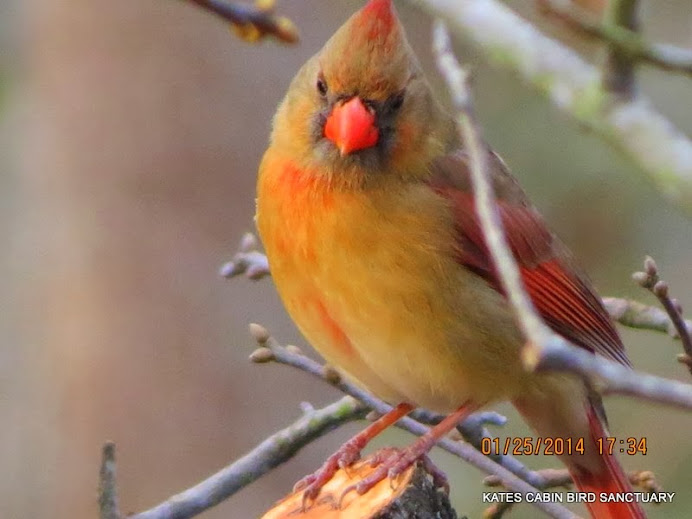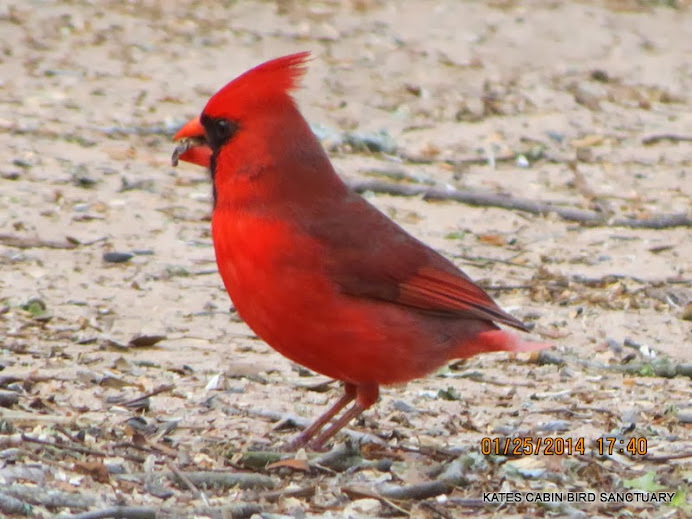
Hi Everybody!!
I caught the whiptail end of that last Polar Vortex and the temps went diving down below freezing again. I had sleet and ice in this location, but some close to me had snow. They closed the schools and overpasses as everybody was slipping and sliding on the icy roads resulting in wrecks. People down here do not know how to drive on ice! Personally, I just hibernated for the day and stayed toasty warm. Today, the sun came out and Spring returned. The cold makes the birds very hungry. Tonight, we celebrate the resident 'Northern Cardinal'. In the bare, cold trees, the scarlet Cardinal is a shining star! Enjoy!




https://en.wikipedia.org/wiki/Northern_Cardinal
Northern Cardinal
From Wikipedia, the free encyclopedia
The Northern Cardinal (Cardinalis cardinalis) is a North American bird in the genusCardinalis; it is also known colloquially as the redbird or common cardinal. It can be found in southern Canada, through the eastern United States from Maine to Texas and south through Mexico. It is found in woodlands, gardens, shrublands, and swamps.
The Northern Cardinal is a mid-sized songbird with a body length of 21 cm (8.3 in). It has a distinctive crest on the head and a mask on the face which is black in the male and gray in the female. The male is a vibrant red, while the female is a dull red-brown shade. The Northern Cardinal is mainly granivorous, but also feeds on insects and fruit. The male behaves territorially, marking out his territory with song. During courtship, the male feeds seed to the female beak-to-beak. A clutch of three to four eggs is laid, and two to four clutches are produced each year. It was once prized as a pet, but its sale as a cage bird is now banned in the United States by the Migratory Bird Treaty Act of 1918.
| Northern Cardinal | |
|---|---|
 | |
| Male in Ohio, USA | |
 | |
| Female in Florida, USA | |
| Conservation status | |
| Scientific classification | |
| Kingdom: | Animalia |
| Phylum: | Chordata |
| Class: | Aves |
| Order: | Passeriformes |
| Family: | Cardinalidae |
| Genus: | Cardinalis |
| Species: | C. cardinalis |
| Binomial name | |
| Cardinalis cardinalis (Linnaeus, 1758) | |
 | |
| Range of C. cardinalis | |
Description[edit]
The Northern Cardinal is a mid-sized songbird with a body length of 20–23.5 cm (7.9–9.3 in) and a wingspan of 25–31 cm (9.8–12 in). The adult weighs from 33.6–65 g (1.19–2.3 oz), with an average 44.8 g (1.58 oz).[6] The male averages slightly larger than the female.[7] The adult male is a brilliant crimson red color with a black face mask over the eyes, extending to the upper chest. The color becomes duller and darker on the back and wings.[8] The female is fawn, with mostly grayish-brown tones and a slight reddish tint on the wings, the crest, and the tail feathers.[9] The face mask of the female is gray to black and is less defined than that of the male. Both sexes possess prominent raised crests and bright coral-colored beaks. The beak is cone-shaped and strong.[8] Young birds, both male and female, show the coloring similar to the adult female until the fall, when they molt and grow adult feathers.[10] They are brown above and red-brown below, with brick-colored crest, forehead, wings, and tail.[4] The legs and feet are a dark pink-brown. The iris of the eye is brown.[4] The plumage color of the males is produced from carotenoid pigments in the diet.[11] Coloration is produced from both red pigments and yellow carotenoid pigments.[12] Northern Cardinal males possess the ability to metabolize carotenoid pigments to create plumage pigmentation of a color different from the ingested pigment. When fed only yellow pigments, males become a pale red color, rather than a yellow.[12] However, there are rare "yellow morph" cardinals, where all feathers (except for black face mask) and beak are a moderate yellow color.
Distribution and habitat[edit]
Northern Cardinals are numerous across the eastern United States from Maine to Texas and in Canada in the provinces of Ontario,Quebec, New Brunswick and Nova Scotia. Its range extends west to the U.S.–Mexico border and south through Mexico to theIsthmus of Tehuantepec, northern Guatemala, and northern Belize. An allopatric population is found on the Pacific slope of Mexico from Jalisco to Oaxaca; note that this population is not shown on the range map. The species was introduced to Bermuda in 1700. It has also been introduced in Hawaii and southern California. Its natural habitat is woodlands, gardens, shrublands, and swamps.[1]
Song[edit]
The Northern Cardinal is a territorial song bird. The male sings in a loud, clear whistle from the top of a tree or another high location to defend his territory. He will chase off other males entering his territory. He may mistake his image on various reflective surfaces as an invading male, and will fight his reflection relentlessly. The Northern Cardinal learns its songs, and as a result the songs vary regionally. It is able to easily distinguish the sex of another singing Northern Cardinal by its song alone.[13] Mated pairs often travel together.[14]
Both sexes sing clear, whistled song patterns, which are repeated several times, then varied. Some common phrases are described as cheeeer-a-dote, cheeer-a-dote-dote-dote,purdy, purdy, purdy...whoit, whoit, whoit, whoit, what-cheer, what-cheer... wheet, wheet, wheet, wheet[15] and cheer, cheer, cheer, what, what, what, what[16] The Northern Cardinal has a distinctive alarm call, a short metallic 'chip' sound. This call often is given when predators approach the nest, in order to give warning to the female and nestlings.[4] In some cases it will also utter a series of chipping notes. The frequency and volume of these notes increases as the threat becomes greater.[4] This chipping noise is also used by a Cardinal pair to locate each other, especially during dusk hours when visibility wanes.
Diet[edit]
The diet of the Northern Cardinal consists mainly (up to 90%) of weed seeds, grains, and fruits. It is a ground feeder and finds food while hopping on the ground through trees or shrubbery. It eats beetles, cicadas, grasshoppers, snails, wild fruit and berries, corn (maize) and oats, sunflower seeds, the blossoms and bark of elm trees, and drinks maple sap from holes made by sapsuckers, an example of commensalism.[17] During the summer months, it shows preference for seeds that are easily husked, but is less selective during winter, when food is scarce. Northern Cardinals also will consume insects and feed their young almost exclusively on insects.[18]
Reproduction[edit]
Pairs mate for life, and they stay together year-round. Mated pairs sometimes sing together before nesting. During courtship they may also participate in a bonding behavior where the male collects food and brings it to the female, feeding her beak-to-beak.[15] If the mating is successful, this mate-feeding may continue throughout the period of incubation.
Males sometimes bring nest material to the female cardinal, who does most of the building. She crushes twigs with her beak until they are pliable, then turns in the nest to bend the twigs around her body and push them into a cup shape with her feet. The cup has four layers: coarse twigs (and sometimes bits of trash) covered in a leafy mat, then lined with grapevine bark and finally grasses, stems, rootlets, and pine needles. The nest typically takes 3 to 9 days to build; the finished product is 5.1–7.6 cm (2.0–3.0 in) tall, 10.1 cm (4.0 in) across, with an inner diameter of about 7.6 cm (3.0 in). Cardinals do not usually use their nests more than once. The female builds a cup nest in a well-concealed spot in dense shrub or a low tree 1–3 m (3.3–9.8 ft) off the ground. The nest is made of thin twigs, bark strips, and grasses, lined with grasses or other plant fibers.[19] Eggs are laid one to six days following the completion of the nest. The eggs are white, with a tint of green, blue or brown, and are marked with lavender, gray, or brown blotches which are thicker around the larger end.[11] The shell is smooth and slightly glossy.[19] Three or four eggs are laid in each clutch. Eggs measure approximately 26 mm × 19 mm (1.0 in × 0.75 in) in size.[11] The female generally incubates the eggs, though, rarely, the male will incubate for brief periods of time. Incubation takes 12 to 13 days.[19] Young fledge 10 to 11 days after hatching. Two to three, and even four, broods are raised each year.[19] The male cares for and feeds each brood as the female incubates the next clutch of eggs.[17]
The oldest wild Cardinal banded by researchers lived at least 15 years and 9 months, although 28.5 years was achieved by a captive bird. Annual survival rates for adult Northern Cardinals have been estimated at 60 to 65%;[20] however, as with other passerine birds, the high mortality of juveniles means that the average lifespan is only about a year.




link to photostudy in Album:
https://plus.google.com/u/0/photos/117645114459863049265/albums/5973065242501873761

...this is brendasue signing off from Rainbow Creek. See You next time!

O+O







No comments:
Post a Comment
Hi Everybody! Please say hello and follow so I know you are here! Due to the inconsideration of people trying to put commercials on my blog comment area, I have restricted use of anonymous posts. Sorry that some hurt all.
My public email is katescabin@gmail.com No spammers or trolls